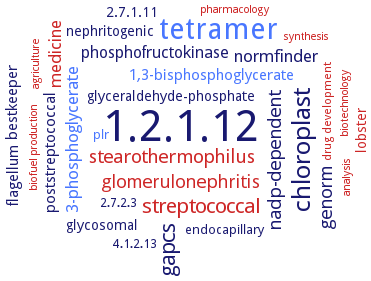1.2.1.12: glyceraldehyde-3-phosphate dehydrogenase (phosphorylating)
This is an abbreviated version!
For detailed information about glyceraldehyde-3-phosphate dehydrogenase (phosphorylating), go to the full flat file.

Word Map on EC 1.2.1.12 
-
1.2.1.12
-
tetramer
-
chloroplast
-
gapcs
-
streptococcal
-
stearothermophilus
-
glomerulonephritis
-
nadp-dependent
-
genorm
-
normfinder
-
medicine
-
3-phosphoglycerate
-
phosphofructokinase
-
flagellum
-
poststreptococcal
-
1,3-bisphosphoglycerate
-
bestkeeper
-
lobster
-
glycosomal
-
2.7.1.11
-
glyceraldehyde-phosphate
-
nephritogenic
-
4.1.2.13
-
plr
-
2.7.2.3
-
endocapillary
-
drug development
-
agriculture
-
biofuel production
-
analysis
-
synthesis
-
biotechnology
-
pharmacology
- 1.2.1.12
- tetramer
- chloroplast
-
gapcs
- streptococcal
- stearothermophilus
- glomerulonephritis
-
nadp-dependent
-
genorm
-
normfinder
- medicine
- 3-phosphoglycerate
-
phosphofructokinase
- flagellum
-
poststreptococcal
- 1,3-bisphosphoglycerate
-
bestkeeper
- lobster
- glycosomal
-
2.7.1.11
-
glyceraldehyde-phosphate
-
nephritogenic
-
4.1.2.13
- plr
-
2.7.2.3
-
endocapillary
- drug development
- agriculture
- biofuel production
- analysis
- synthesis
- biotechnology
- pharmacology
Reaction
Synonyms
3-phosphoglyceraldehyde dehydrogenase, A4-GAPDH, A4-glyceraldehyde-3-phosphate dehydrogenase, AB-GAPDH, AnBn-GAPDH, AsGAPDH, At3g04120, BARS-38, CbbG, CgGAP, Clo1313_2095, complement-C3-binding protein, CP 17/CP 18, Ctherm_Gapdh, cytosolic NAD-dependent glyceraldehyde 3-P dehydrogenase, cytosolic phosphorylating glyceraldehyde-3-phosphate dehydrogenase, D-glyceraldehyde-3-phosphate dehydrogenase, D-glyceraldehyde-3-phosphate: NAD+ oxidoreductase (phosphorylating), dehydrogenase, glyceraldehyde phosphate, dihydrogenase, glyceraldehyde phosphate, EcGAPDH, EcGAPDH1, FgGAPDH, FhGAPDH, G3PD, G3PDH, Ga3P dehydrogenase, Ga3PDHase, GADPH, GAP, GAP1, gap2, GapA, GapB, GAPC, GapC-1, GapC1, GapC2, GAPCp, GAPCp1, GAPCp2, GAPD, GAPDH, GAPDH type 1, GAPDH1, GAPDH2, GAPDH3, GAPDHS, GAPDS, GAPN, GBS GAPDH, glyceraldehyde 3-phosphate dehydrogenase, glyceraldehyde 3-phosphate dehydrogenase-S, glyceraldehyde phosphate dehydrogenase (NAD), glyceraldehyde-3 phosphate dehydrogenase, glyceraldehyde-3-P-dehydrogenase, glyceraldehyde-3-phosphate dehydrogenase, glyceraldehyde-3-phosphate dehydrogenase (NAD), glyceraldehyde-3-phosphate dehydrogenase 1, glyceraldehyde-3-phosphate dehydrogenase, type I, glyceraldehyde-3-phosphate dehydrogenase-spermatogenic protein, glyceraldehyde-3-phosphate dehydrogenase-spermatogenic protein GAPDHS, glyceraldehyde-3-phosphate dehydrogenases, GPD, GPD2, Gra3PDH, GraP-DH, H.c-C3BP, hGAPDH, HsGAPDH, kmGAPDH1p, Larval antigen OVB95, Major larval surface antigen, Mtb-GAPDH, NAD+-dependent GAPDH, NAD+-dependent glyceraldehyde 3-phosphate dehydrogenase, NAD+-dependent glyceraldehyde-3-phosphate dehydrogenase, NAD+-G-3-P dehydrogenase, NAD+-GAPDH, NAD-dependent Ga3PDHase, NAD-dependent glyceraldehyde 3-phosphate dehydrogenase, NAD-dependent glyceraldehyde phosphate dehydrogenase, NAD-dependent glyceraldehyde-3-phosphate dehydrogenase, NAD-dependent non-phosphorylating glyceraldehyde-3-phosphate dehydrogenase, NAD-dependent phosphorylating glyceraldehyde-3-phosphate dehydrogenase, NAD-G3PDH, NAD-GAPDH, NADH-glyceraldehyde phosphate dehydrogenase, P-37, p-GAPDH, PfGAPDH, phosphoglyceraldehyde dehydrogenase, phosphorylating NAD+-dependent GAPDH, Plasmin receptor, Plasminogen-binding protein, plastidial glyceraldehyde-3-phosphate dehydrogenase, pmGAPDH, PyGapdh, rmGAPDH, Rv1436, somatic GAPD, somatic glyceraldehyde 3-phosphate dehydrogenase, sperm-specific GAPDS, sperm-specific glyceraldehyde 3-phosphate dehydrogenase, sperm-specific glyceraldehyde-3-phosphate dehydrogenase, TaeNAD-GAPDH, TagapC, TDH1, TDH2, TDH3, TLAb, triose phosphate dehydrogenase, UDG, uracil-DNA glycosylase, vGPD


 results (
results ( results (
results ( top
top






